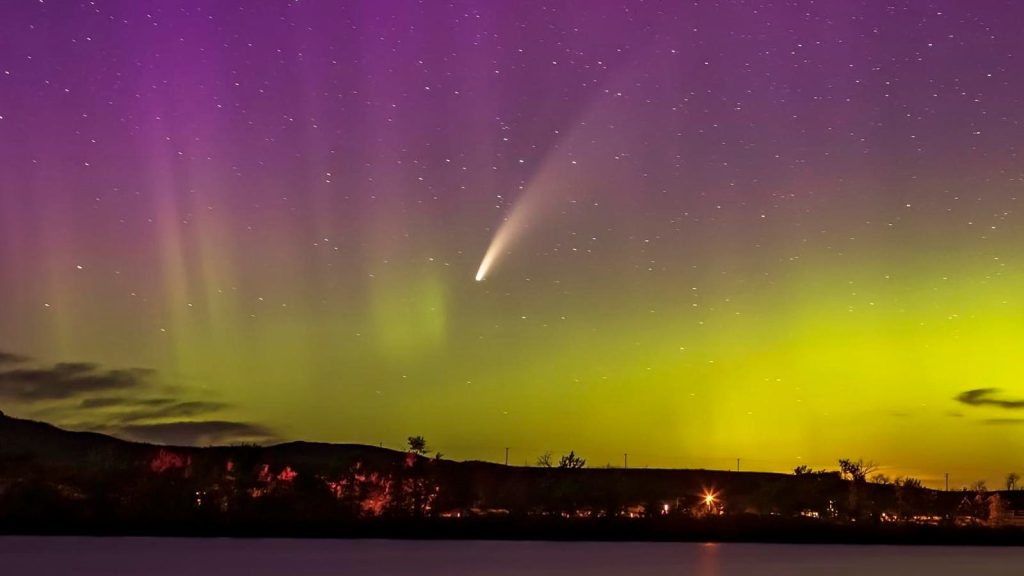Did you see the comet this week and the Northern Lights last week? With little auroral activity since, photographers’ dreams of creating images including both rare sky phenomena appear to be fading. However, there might be a chance to capture both tonight in some northeastern and north-central U.S. states, in Canada, and in far northern Europe.
This is not going to be an exciting all-sky event by any means, but those in a select few northern continental U.S. states may see aurora on Tuesday night as a G1 geomagnetic storm strikes Earth’s atmosphere, according to the latest forecast from the National Oceanic and Atmospheric Administration.
It’s predicting a G1 storm with a Kp 4.67 magnitude between 00:00-03:00 UTC, which is 8:00-11:00 p.m. EDT, 7:00-10:00 p.m. CDT and 6:00-9:00 p.m. MDT and 5:00-8:00 p.m. PDT on Monday, Oct. 15.
Don’t Expect An ‘Extreme’ Display Of Aurora
Tonight’s likely weak aurora comes in the wake of the events of Thursday, Oct. 10 and Friday, Oct. 11, when the Northern Lights were seen across the U.S. — and as far south as Mexico — after a G5 (Extreme) geomagnetic storm. It was one of the most powerful geomagnetic storms of the century. That will be a hard act to follow. (If you missed them, here’s probably why).
An extreme G5 is not what’s happening tonight — far from it — and it’s difficult to predict where and when exactly the Northern Lights will show up on Tuesday night, but those in northern-tier U.S. states may get a glimpse of at least photographic aurora (aurora detectable only by camera or smartphone). After all, a G1 is the weakest storm classification.
Where To See The Northern Lights Tonight
Continental U.S. states within the aurora’s view line include Washington, Idaho, Montana, North Dakota, South Dakota, Minnesota, Wisconsin, Michigan and Maine.
If you’re in one of these states, don’t bother searching out dark rural skies on a light pollution map or by visiting an International Dark Sky Places because the moon is on the cusp of being full, so it will bleach the night sky.
How To See And Photograph The Comet And The Northern Lights
Not much to get excited about? Possibly not, but with comet C/2023 A3 (Tsuchinshan-ATLAS) visible to the naked eye this week there could be a chance to grab an image like the one above. Here’s how to photograph the comet and here’s how to photograph the Northern Lights with a camera and a smartphone. The techniques are very similar.
Tuesday, Oct. 15, is the second of the two best opportunities to see the comet at its brightest and best from the northern hemisphere. The comet is currently visible in the west about 45 minutes after sunset from the Northern Hemisphere and for about an hour and 40 minutes afterward (though do check the exact time of sunset where you are and the comet’s setting times on Stellarium Web for times accurate for your exact location). Keep an eye on NOAA’s 30-minute forecast.
Why The Northern Lights Are So Active This Year
Geomagnetic activity peaks when the sun is close to “solar maximum” — the peak of its 11-year solar cycle — and intensifies in the weeks after late Septemer’s equinox, when Earth’s axis is tilted side-on to the sun. Both of those conditions are being met right now.
SWPC’s latest forecast is for the sun to reach solar maximum between August 2024 and January 2025. However, the high number of solar flares and coronal mass ejections from the sun (which are currently causing the frequent and powerful geomagnetic storms) can often be strongest in the two years after solar maximum. Consequently, displays of Northern Lights at lower latitudes look set to continue through 2026.
Wishing you clear skies and wide eyes.
Read the full article here










